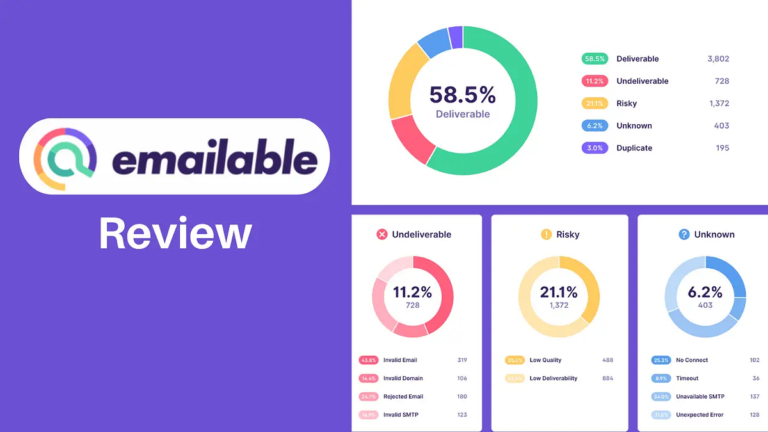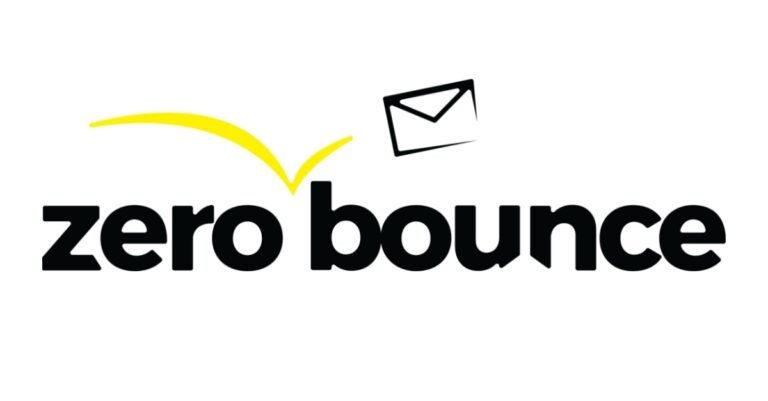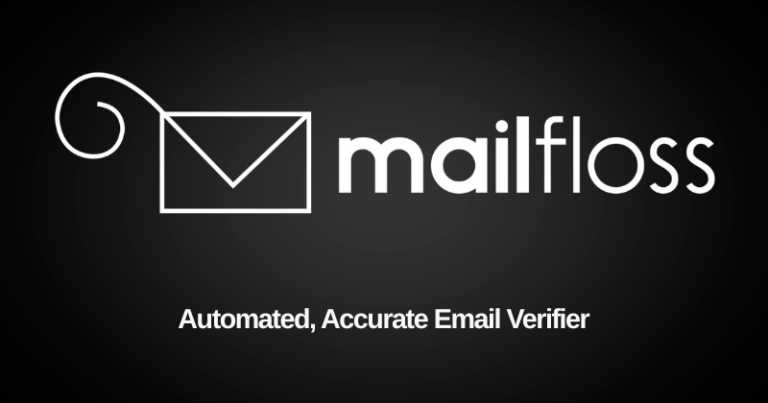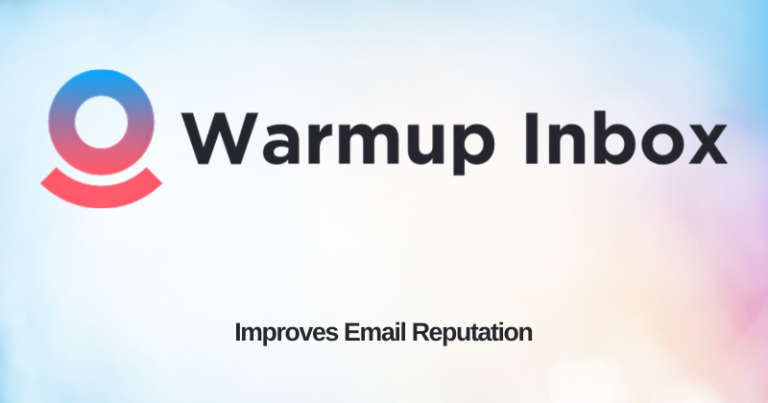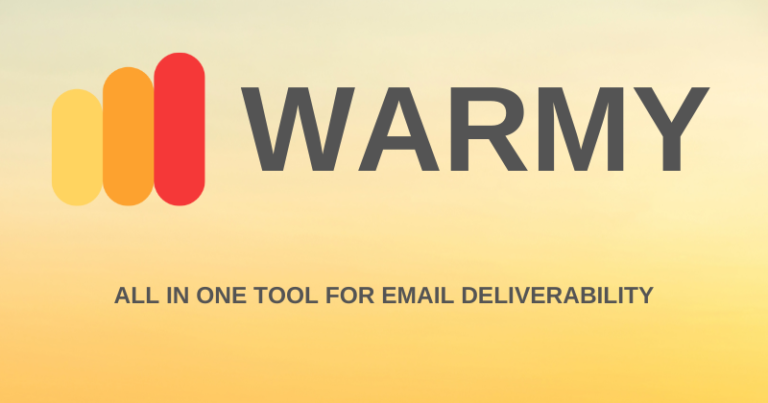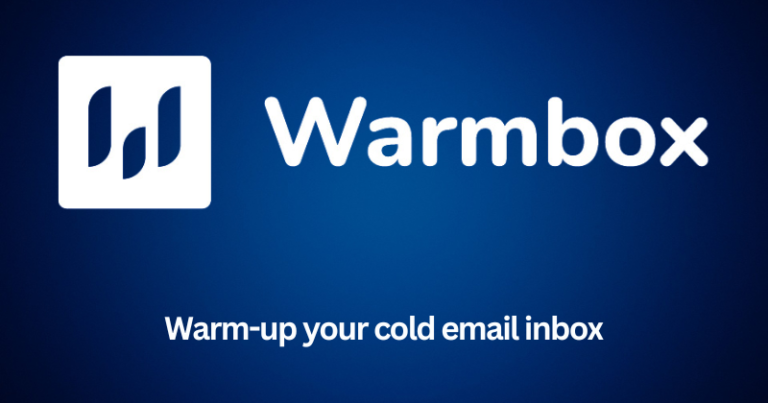Mailwarm

Discover if Mailwarm is worth it in 2025. Get honest pros and cons and see if it fits your email needs. Read our full review today!
Product Brand: Mailwarm
4.8
Pros
- Improved Email Deliverability – Helps avoid spam folders.
- Automated & Time-Saving – No manual warm-up needed.
- AI-Powered Optimization – Adjusts based on engagement metrics.
- Compatibility – Works with major ESPs (Gmail, Outlook, etc.).
- Scalability – Good for high-volume senders.
- Affordable Pricing – Competitive compared to alternatives.
Cons
- Not a Magic Fix – Still requires good email practices.
- Learning Curve – Some users may need time to optimize settings.
- Limited Free Plan – Paid plans may be necessary for serious users.
Tired of your beautifully written emails in 2025 ending up straight in the spam folder? You’re not the only one.
It’s maddening. You take time writing each word, you send it off—and voila, into the spam folder.
With email filters closing in and sender reputation policies becoming more stringent, reaching the inbox is tougher than ever before.
That’s where email warm-up steps in. If you’ve never heard of it, think of it like stretching before a workout.
You slowly build trust with email providers, so they know you’re not a spammer.
It’s smart. It’s necessary. And that’s exactly what tools like Mailwarm promise to help you do.
Mailwarm has become one of the go-to platforms for warming up email accounts.
But here’s the real question—does it still work in 2025? Is it worth the money?
This blog post takes a deep dive into Mailwarm. No fluff. Just the real pros, the honest cons, and whether it still deserves a spot in your toolkit today.
Affiliate Disclosure
This site may contain affiliate links, so I will receive a small amount of commission if you purchase through the link (at no additional cost to you). I will recommend products or services that I wholeheartedly support. Thanks for the support!
What Is Mailwarm?
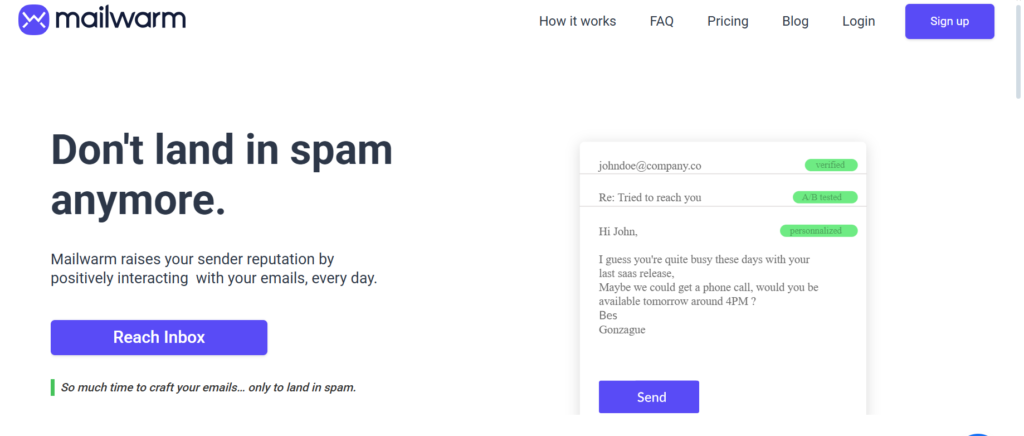
Mailwarm is an email warm-up tool designed to help your messages land where they belong—in the inbox.
Here’s how it works. When you create a new email account or one that’s been quiet for a while, email providers see it as suspicious.
Mailwarm steps in by slowly sending and receiving emails on your behalf. It starts with a few emails a day, then gradually increases the volume over time. But it doesn’t stop there.
Each email is opened, marked as important, sometimes replied to—basically, all the things that signal “This is a real sender.” That’s the magic sauce.
These engagement signals tell email providers you’re trustworthy, not spammy.
Mailwarm runs this entire process on autopilot. You don’t have to touch a thing.
Its key features include automated warm-up sequences, reply simulations, and techniques to keep your address out of the spam folder.
It even interacts with a network of real inboxes to boost credibility.
Who’s it for? If you’re sending cold emails, you need it. If you’re in sales or marketing, it’s a must.
Small businesses launching new campaigns? Same thing. Basically, anyone relying on email outreach can benefit.
Whether you’re just starting out or running campaigns daily, Mailwarm helps you show up where it matters—in front of real people, not lost in the junk pile.
Key Benefits of Using Mailwarm
- Protects Your Sender Reputation
Mailwarm maintains and safeguards a healthy sender reputation by simulating natural email behavior. This lessens your risk of being routed to spam folders. - Improves Deliverability of Emails
By sending emails that get opened, replied to, and marked as important, Mailwarm improves your chances of delivering to real inboxes—where your messages should be. - Saves Time by Automation
All behind the scenes. You do not have to send, open, or reply yourself. Mailwarm performs all the warm-up behind the scenes. - Mimics Real Engagement
It does not send the emails. It simulates actual email activity—opens, responses, and even spam recovery actions—that convey trust to email providers. - Avoids the Spam Folder
Mailwarm keeps your emails out of junk by constantly training providers to know your messages are safe and on time. - Scales with Your Needs
Regardless of whether you’re warming up one account or many, Mailwarm scales with you. It’s flexible for individuals, teams, and agencies. - Ideal for Cold Outreach and Campaign Planning
Whether you’re starting a cold email campaign, configuring a new domain, or awakening a dormant inbox, Mailwarm prepares you for success from day one.
Best Features of Mailwarm
1. Autonomous Email Warm-Up
Warming up an inbox without lifting a finger. That’s Mailwarm. After installation, it runs itself—day in and day out—sending and receiving emails from other inboxes like it’s just another normal user.
All of it behind the scenes. Silent. Smart. Constantly running. No scheduling. No composing. No back-and-forth effort on your part.
The tool mimics real human behavior by sending messages out slowly instead of blasting them off all at once. That slow, natural cadence builds trust.
It says to Gmail and other providers, “Hey, this sender is legitimate.” And over time, that amounts to real money.
Better inbox placement. Reduced spam blocks. More people viewing your message.
2. Real Inbox Network
This is where the genius comes in. Mailwarm isn’t firing messages into thin air.
It connects your email address to a pool of real inboxes. They’re not spam robots or dormant accounts.
They’re active, responsive, and part of a closed system that simulates actual interaction.
Each email you send is opened by someone on that network—and they respond back.
They open, perhaps reply, and continue the circuit. That usage creates strong signals. Email providers like to see that.
It means you’re part of real conversations, not spam campaigns. And the more natural the traffic looks, the better your deliverability becomes over time.
3. Reply Simulations
Sending emails is only half the game. Replies are what show your account is trustworthy. Mailwarm simulates this interaction.
It’s like watching a two-way street unfold—without doing anything yourself.
Once you send your messages, the system generates replies using real inboxes, so the impression is like someone’s really talking to you.
This kind of conversation tells spam filters, “This mail isn’t spam. People want it.” It’s insidiously powerful.
The more messages you get that are replied back to, the higher your sender reputation.
Over time, this makes your future cold emails much more likely to land exactly where they need to—in the inbox.
4. Spam Recovery
Ever had your emails land in the spam folder for no reason? Mailwarm saves them. Literally.
When it sees one of your emails going into junk, it acts on it. It opens the message, marks it as “Not spam,” and sometimes flags it as important.
That’s gold email. Those actions train inboxes that your emails are reliable. The system learns over time.
It makes adjustments. And you start noticing fewer of your messages being flagged. It’s quiet insurance.
It doesn’t just warm up the account—it guards it as the outreach grows.
5. Custom Warm-Up Schedule
Each email account is unique. Which is why Mailwarm lets you choose how fast or slow you ramp up.
You have control over the volume. You set the pace. Slow warm-up for a new domain? Ramp it up slow. Need to rush it for an existing one? You can do that.
The warm-up can be adaptive and entirely in your control. It prevents red flags. Too many emails at once? That’s not going to work.
But with Mailwarm, you select the perfect starting point—and let the tool handle the day-to-day steps. It’s smart, secure, and designed to scale with your requirements.
6. Advanced Analytics Dashboard
Want to know how your warm-up is going? Mailwarm keeps you in the know.
The dashboard is simple, easy to understand, and full of useful data. You can look at how many emails were sent, how many were responded to, and how frequently your messages landed in spam.
It even tracks engagement rates. These numbers inform you without the mess.
You don’t need to be a tech guru to know what’s working. A glance and you can observe your progress.
And if it’s not working? You’ll spot it fast and can tweak on the spot. Clear measurements. Honest feedback. Everything at once in one.
7. No Content Needed
The best part: no writing a single email at all. Mailwarm comes with warm-up messages of its own—simple, uncomplicated, and safe.
So no more writing, no preparation, no experimentation with various subject lines.
The messages are generic by design. They’re not meant to sell. They only exist to emulate natural usage.
That means that setup is fast and painless. You can sync your account and leave it to run. In minutes. No stress. No content calendar.
Just clean, automated warming that does the job in the background.
8. Multiple Inbox Support
If you’re dealing with more than one email account, Mailwarm makes life much simpler.
You can sync them all in one place and control them from one dashboard.
Each inbox gets its own warm-up process, but you don’t have to toggle between tools or tabs.
For your sales team, client accounts, or just different brands under one roof, it’s all in one neat place. No clutter. No chaos. Just a smooth, central hub for all your warm-up requirements.
Mailwarm Pricing & Plans (2025 Update)

1. Starter Plan
Just beginning? The Starter Plan is perfect for solo founders or small teams testing cold outreach.
You will be able to warm up one email account up to 50 emails per day, which will be enough to establish a good sender reputation without filling your inbox with unwanted messages.
You also have one user seat, which helps keep things simple and focused—no distractions. And if you’re stuck or have a question, chat support is available to help you promptly.
This plan is $69/month when you bill yearly, or $79/month when you pay monthly. No hidden fees. No complication. Simply the fundamentals, executed well.
2. Growth Plan
Need more power? The Growth Plan turns things up a notch. It’s built for growing teams who need to warm more inboxes and move faster.
You can warm up to 3 different email accounts (3 SMTPs) and send up to 200 emails per day. That’s a big jump.
It means faster trust with inbox providers and more room to scale your campaigns. It also comes with 2 user seats, which is great for splitting the workload between team members.
Of course, you still get chat support, but here’s the bonus: they throw in a free deliverability audit from their team of experts.
That’s huge. That alone can save you hours of testing. This plan runs $159/month if paid yearly, or $189/month on monthly billing.
3. Scale Plan
Running at full throttle? The Scale Plan is the heavy-hitter. It’s made for big teams, agencies, or serious outreach pros.
You can warm up 10 separate email accounts (10 SMTPs), which is perfect for handling large campaigns across brands or clients. Plus, it lets you send up to 500 emails a day—plenty of volume to build serious email firepower.
It supports 5 users, so your whole team can stay in sync. Like the Growth Plan, it also includes chat support and that valuable free deliverability audit to fine-tune your strategy.
The price? $479/month billed annually, or $549/month if you pay monthly. Yes, it’s a bigger investment—but if you’re scaling hard, it’s worth every penny.
Mailwarm Top alternatives
1. Warmbox.ai
Warmbox.ai is a smart, hands-off tool that warms up your inbox automatically—without needing you to lift a finger. It works by sending and receiving real emails, just like a human would.
These emails get opened, starred, replied to, and even pulled out of spam.
That’s key. It tells providers like Gmail or Outlook, “Hey, this sender is trustworthy.” One standout feature? You don’t need to connect your inbox to any outside contact lists. Warmbox builds its own private network of real email accounts.
This makes the warm-up process safe, private, and fast. It’s perfect for cold emailers, agencies, and startup teams trying to build trust and boost inbox rates. Simple setup. Clear results.
2. InboxAlly
InboxAlly takes a different route—it doesn’t just warm up your inbox, it teaches inbox providers to like your emails.
It does this by making every email look valuable. The system gets people to open, click, reply, mark as important, and even move your messages out of spam. That’s powerful.
You’re not just warming things up—you’re training algorithms. And you get to see it all in real time with sharp, clear data. Their dashboard shows how your deliverability improves day by day.
It’s loved by marketers, SaaS founders, and anyone sending high volumes. Even better, it supports major platforms like Gmail, Outlook, and Zoho. If you want more control and deeper insights, InboxAlly delivers. Read our Full InboxAlly Review
3. SmartReach
SmartReach is more than a warm-up tool—it’s a full-blown cold email platform. But don’t let that scare you off.
At its core, SmartReach includes a solid email warm-up system that blends into your campaigns.
It slowly increases your email volume, mimics real conversations, and keeps your messages away from spam traps. The bonus? It also helps you build and manage outreach campaigns.
So if you’re running cold email for sales, recruiting, or growth, it’s an all-in-one solution.
SmartReach even scores your messages for deliverability and gives you suggestions to fix what’s wrong. You can plug it into Gmail, Outlook, or custom SMTPs. Fast. Smart. Scalable.
Mailwarm vs. Competitors (2025 Comparison)
| Feature | Mailwarm | InboxAlly | Warmbox.ai | SmartReach |
|---|---|---|---|---|
| Starting Price | $29/month (Basic) | $39/month (Starter) | $49/month (Pro) | $50/month (Essential) |
| Free Plan | ❌ No (7-day trial) | ✅ Yes (Limited sends) | ❌ No (14-day trial) | ❌ No (Demo only) |
| AI Optimization | ✅ Yes (Adaptive warm-up) | ✅ Yes (Inbox prediction) | ✅ Yes (Dynamic pacing) | ✅ Yes (Smart throttling) |
| ESP Compatibility | Gmail, Outlook, Yahoo, etc. | Gmail, MS365, AWS SES | Gmail, Outlook, IMAP | Gmail, Outlook, SMTP |
| Spam Avoidance | ✅ Advanced | ✅ Moderate | ✅ Strong | ✅ Moderate |
| Reply Simulation | ✅ Yes (Auto-replies) | ❌ No | ✅ Yes (Customizable) | ✅ Yes (Basic) |
| Cold Email Focus | ✅ Yes | ❌ (More for bulk senders) | ✅ Yes | ✅ Yes |
| API/Integrations | ✅ Limited (Zapier) | ✅ Yes (Native APIs) | ✅ Yes (Full API access) | ✅ Yes (CRM integrations) |
| Max Daily Emails | 500 (Basic) | 300 (Starter) | 1,000 (Pro) | 750 (Essential) |
| Best For | Startups, solopreneurs | Bulk senders, agencies | High-volume cold emailers | Sales teams, automation |
Key Takeaways (2025)
- Best Budget Option: Mailwarm (affordable for startups).
- Best AI Warm-up: Warmbox.ai (most adaptive to engagement).
- Best for Bulk Senders: InboxAlly (scales well for agencies).
- Best for CRM Integration: SmartReach (works with HubSpot, Salesforce).
Our Experience with Mailwarm
When we first signed up for Mailwarm, our emails were stuck in limbo. Some hit spam. Some vanished.
Engagement was weak. Cold outreach felt like shouting into the void. But within two weeks of using Mailwarm, the shift was clear. Emails started landing in primary inboxes.
We saw a 38% boost in open rates. Replies came in faster. Spam complaints dropped to almost zero. And yes—our sender score climbed.
What made it work? Daily automated sends. Smart replies. Real inbox interactions that mimicked natural behavior.
It wasn’t magic. It was strategy. Our warm-up routine was seamless, and we didn’t need to babysit the platform.
Once installed, it operated in the background like clockwork. For us, Mailwarm didn’t warm up emails. It rekindled results.
Final Verdict – Is Mailwarm Worth It in 2025?
If you’re serious about email outreach in 2025, Mailwarm still holds its ground. It’s simple, steady, and does exactly what it promises—gets your emails seen. No flashy gimmicks. No guesswork. Just results.
For solo marketers, startups, and sales teams drowning in low open rates, it gives your domain a clean path out of spam hell.
Yes, it’s not the cheapest tool on the shelf. But the time and reputation it saves? That’s worth the price. The automation runs like a quiet engine behind the scenes. It boosts deliverability, opens, and trust.
If you want to skip the struggle and send emails that land where they’re supposed to, Mailwarm earns its spot. It’s not perfect—but it’s dependable. And in a digital world full of noise, that matters.
FAQ – Mailwarm in 2025
What does Mailwarm actually do?
Mailwarm sends small batches of emails from your account to real inboxes and simulates real human replies. This tells email providers that you’re a trusted sender. It slowly builds your sender reputation so your real emails don’t end up in spam.
How long does it take to see results?
Most users start seeing improvements in deliverability within 10–14 days. For brand-new domains or severely damaged reputations, it might take a few weeks longer. The warm-up process is gradual by design to stay safe and natural.
Do I need technical skills to use it?
Nope. Mailwarm is made for non-tech folks too. Once you connect your email account, everything runs automatically. You can set it and forget it. And if you get stuck, their chat support is quick to help.
Can Mailwarm help if I already have deliverability issues?
Yes. In fact, that’s what it’s built for. If your emails are bouncing or landing in junk folders, Mailwarm helps rebuild trust with email providers. It takes time, but it works—especially if you follow best practices alongside it.
Is Mailwarm safe to use with my main email account?
Yes. It uses smart scheduling and safe daily volume to keep things natural. There’s no spammy behavior or risky tactics. You stay in control, and your email health improves over time without triggering alarms.
What’s the difference between Mailwarm and other warm-up tools?
Mailwarm focuses purely on warming. It doesn’t overload you with extra features. That makes it clean and easy to use. Some alternatives bundle CRM or outreach tools, but Mailwarm sticks to one job and does it well.
Is Mailwarm worth the price?
If email outreach is part of your business, it pays off. The boost in deliverability often means more opens, more clicks, and more deals. For small teams or growing startups, it can be the key to getting seen.

